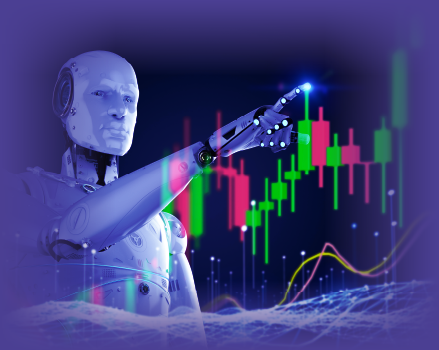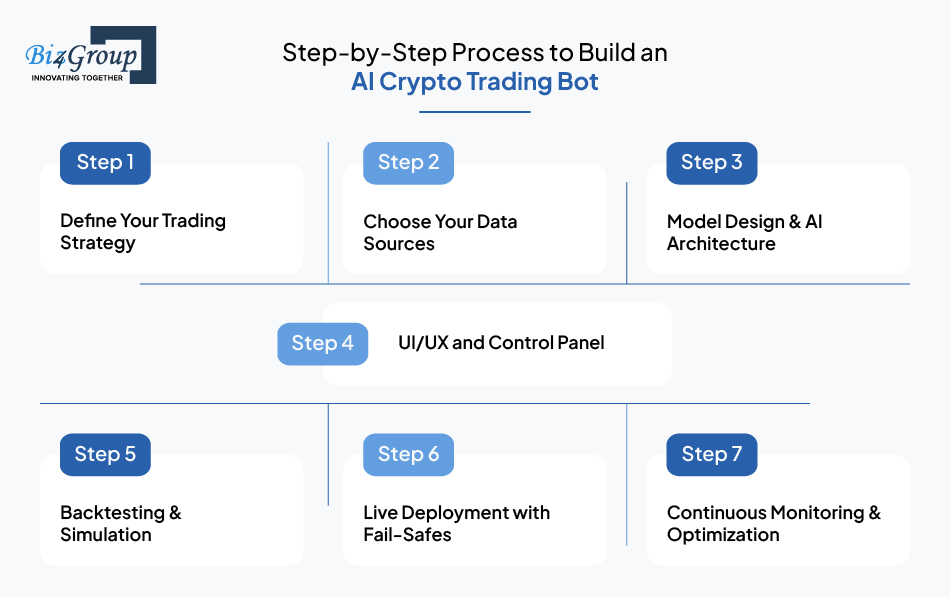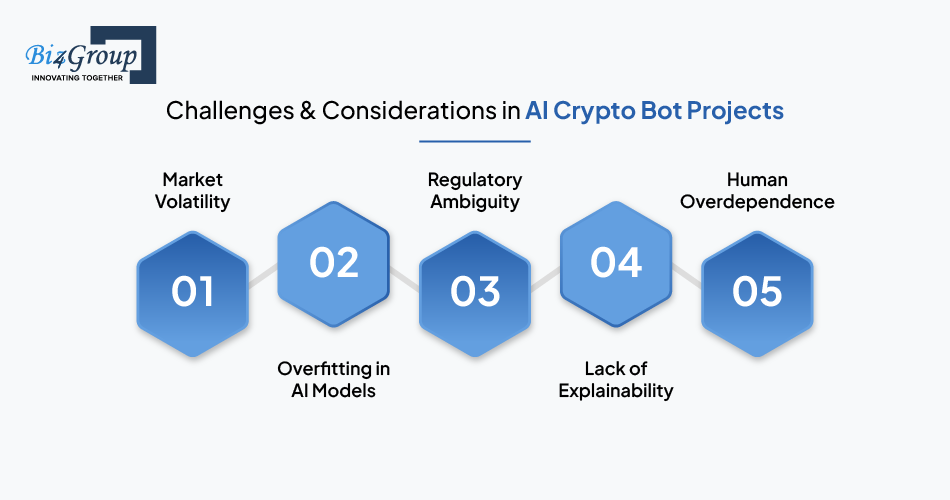Basic AI Chatbot Pricing: A simple chatbot that can answer questions about a product or service might cost around $10,000 to develop.
Read More

AI Crypto Trading Bot Development enables real-time, data-driven decisions using ML, NLP, and multi-agent systems — ideal for automating and optimizing crypto portfolios.
Development costs range from $10,000 to $150,000+, depending on complexity, AI stack, compliance features, and exchange integrations.
Advanced features include auto-rebalancing, sentiment analysis, multi-agent collaboration, real-time risk recalibration, and integration with live market data feeds.
Security, scalability, and smart UX/UI are critical — so partnering with the right AI development team is non-negotiable.
Imagine This:
“You’re running a crypto hedge fund. It’s 2:00 a.m. in New York.
The market in Asia just dipped 12%, and your portfolio should rebalance… but your traders are asleep.”
Except one.
Your AI-powered crypto trading bot detects the trend, evaluates impact, recalibrates your assets, and executes a flawless order — in under a second. No coffee. No panic. No missed opportunity.
That’s not a pitch. That’s the new reality of intelligent trading.
Why Everyone's Building Bots That Think?
AI bots in crypto aren't just rule-based bots on steroids. Today’s intelligent bots are:
This is the essence of AI Crypto Trading Bot Development — creating adaptive, data-driven systems that act like seasoned traders (minus the emotional rollercoaster).
But here’s the kicker: building one requires more than just coding skills.
You need a tech partner who understands quant logic, data modeling, and exchange mechanics — a team with the precision of a hedge fund and the agility of an AI development company built for modern finance.
The AI crypto trading bot market is no longer a playground for tech-savvy solo traders — it’s becoming a core pillar for institutional desks, fintech platforms, and even traditional hedge funds.
What’s driving the shift?
Forward-looking firms are no longer building static trading rules. Instead, they’re investing in AI trading agent development that fuses machine learning with real-time decision-making. These agents process news sentiment, on-chain data, and order book signals — acting on insights faster than any team could.
And as more capital moves algorithmic, the race isn’t about who builds a bot — it’s about who builds the smarter one.
Want to automate trades and stay ahead of market shifts?
Schedule CallLet’s clear one thing up: an AI crypto trading bot is not just a fancier spreadsheet with a trading script slapped on it.
It’s a self-improving agent — one that watches the market, reads signals, backtests strategies, and adapts in real-time. Think of it as a junior trader who never burns out and learns after every execution.
While a crypto AI trading bot might sound similar to rule-based bots, the difference lies in how they "think":
In most projects, development starts with defining a strategy, then evolves into modeling behavior using AI/ML — a methodology explored in our work with AI trading bot development frameworks.
Here’s what happens behind the scenes when you launch an AI bot crypto trading system:
So, whether you're managing high-volume trades or micro-position scalping, an AI cryptocurrency trading bot can react and recalibrate faster than any human team.
|
Feature |
Traditional Bot |
AI Crypto Trading Bot |
|
Decision Logic |
Rule-based (static) |
Machine learning (adaptive) |
|
Market Reactivity |
Predefined triggers |
Dynamic market analysis |
|
Learning Over Time |
None |
Self-improving models |
|
Data Sources |
Basic price feeds |
News, social sentiment, blockchain |
|
Trade Execution |
Fixed logic |
Risk-optimized, real-time logic |
|
Performance Optimization |
Manual updates |
Continuous via ML |
Whether you’re exploring an AI trading bot for crypto or looking to scale your AI crypto bot trading architecture, the key is understanding that this isn’t just about automation — it’s about intelligence that evolves.
What separates a weekend-code bot from a revenue-driving AI engine?
Core features — designed not just to trade, but to outperform and adapt.
When you work with a seasoned AI App Development Company, you get more than models and APIs — you get features engineered for scale, risk, and real-time decisions.
Here’s what your AI based crypto trading bot must include:
|
Feature |
What It Does |
|
Real-Time Data Sync |
Pulls from exchange APIs, price feeds, and blockchain data without delay |
|
Multi-Exchange Support |
Trades across Binance, Coinbase, Kraken, etc., from a single engine |
|
Custom Trading Strategies |
Implements scalping, arbitrage, DCA, swing, or long-short strategies |
|
Risk Management Module |
Sets stop-loss, take-profit, portfolio rebalancing, and exposure limits |
|
Backtesting Engine |
Runs strategy simulations on historical data to fine-tune logic |
|
Sentiment Analysis |
Analyzes news headlines and social feeds to gauge market sentiment |
|
Trade Execution Optimization |
Minimizes slippage, splits orders, and times entries/exits intelligently |
|
Performance Dashboard |
Real-time reports, metrics, and ROI tracking for ongoing improvement |
|
Secure Authentication & Logging |
Uses multi-layer security and maintains logs for auditing and compliance |
A well-built AI bot isn’t just smart — it’s equipped to handle chaos without crashing, thanks to these essential capabilities.
Once you’ve nailed the fundamentals, it's the advanced features that separate winners from the rest of the market. These aren't gimmicks — they’re edge-creators.
Teams investing in serious AI trading crypto bot capabilities are going beyond execution and into predictive logic, proactive alerting, and real-time sentiment fusion.
These are the kinds of features we design in our Enterprise AI Solutions — tailored to handle volatility and scale.
|
Advanced Feature |
Value Add |
Cost Impact |
|
Reinforcement Learning Models |
Learns from previous trades to improve decision-making |
+$6,000–$12,000 |
|
Predictive Analytics Engine |
Anticipates market movement based on pattern recognition |
+$5,000–$8,000 |
|
AI Sentiment Fusion |
Combines Reddit, X (Twitter), and news with price movement for smarter trades |
+$4,000–$7,000 |
|
Multi-Agent Architecture |
Uses multiple AI agents for portfolio balancing, hedging, etc. |
+$8,000–$15,000 |
|
Real-Time Risk Recalibration |
Adjusts strategy mid-session as volatility increases |
+$3,000–$5,000 |
|
Voice-Controlled Dashboard |
Enables verbal command trading via integrated NLP |
+$2,500–$6,000 |
These aren’t just “nice to have.” For enterprise-grade bots, features like multi-agent logic and predictive sentiment scoring can help you execute trades seconds before the crowd reacts — a measurable edge in a high-speed market.
From backtesting to deployment — we’ll walk you through it.
Request AI ConsultationImagine your AI powered crypto trading bot places a high-volume buy order based on faulty sentiment data... only to crash the system and trigger a regulatory audit.
It’s not fiction — it’s happened. More than once.
In the world of AI + finance, a great strategy means nothing without airtight security and compliance foresight. Most decision-makers realize this only after their MVP hits production — which is a costly mistake.
When you're working with a seasoned AI consulting services partner, security isn't tacked on — it's woven in from step one.
Every AI bot that touches trading accounts or user data must be:
Your investors and users won’t trust your platform without visible, built-in compliance. You’ll need:
The takeaway?
Building a smart bot is impressive.
Building a secure and compliant one is bankable.
We’ve seen too many projects reverse-engineer compliance — a painful and expensive route. The right way? Embed security and compliance in parallel with AI model development.

Building an AI crypto trading bot app isn’t just about throwing TensorFlow at some Bitcoin data. You need structured phases, the right tools, and a dev team that understands both machine learning and market microstructures.
Here’s how to create an AI crypto trading bot — step by step:
Before a single model is trained, outline exactly what the bot should do.
Scalping? Arbitrage? Momentum-based entries? Portfolio balancing?
Your strategy must align with:
This strategic clarity will become the foundation for AI model training.
Your bot is only as smart as the data it sees.
Common inputs include:
The goal is to feed your bot the same signals that human traders watch — just faster and continuously.
Here’s where you bring in an experienced AI Agent Development Company to architect the machine learning pipeline.
Typical choices:
Remember, not all models are created equal — especially when it comes to execution speed, memory footprint, and overfitting resistance.
Traders don’t want to babysit a terminal.
You’ll need a responsive, intuitive interface where users can:
Partnering with a specialized UI/UX Design Company ensures your bot isn’t just smart — it’s usable.
Run historical trades using past market data to measure:
This step is where most DIY bots fail. If it can’t pass the past, it won’t survive the present.
Integrate with target exchanges (Binance, Kraken, etc.), monitor performance, and add:
This is also when you bring in compliance (see Section 7) to certify the bot for real-world use.
Post-deployment, your team needs:
This is the phase where an AI crypto trading bot app evolves — getting smarter with every trade, every dataset, and every user behavior trend.
Full-stack compliance, analytics, and risk logic — tailored for institutions.
Request ProposalLet’s answer the question everyone eventually asks:
How much does it cost to build an AI crypto trading bot?
The short answer:
It depends on what you want your bot to do — and how fast, smart, and secure you want it to be.
The long answer? Let’s break it down.
If you’re working with a seasoned Trading Software Development Company, these considerations are mapped early in the scoping phase.
|
Type of Bot |
Ideal For |
Core Features |
Estimated Cost |
|
Starter Bot |
Individual traders or early-stage startups |
Rule-based triggers, price alerts, single-exchange execution |
$10,000 – $20,000 |
|
AI-Enabled Bot |
Scaling teams or fintech firms |
ML-based predictions, backtesting engine, portfolio analytics |
$20,000 – $40,000 |
|
Enterprise Bot |
Institutions, hedge funds |
Multi-agent AI, real-time risk recalibration, sentiment analysis, audit logs |
$60,000 – $150,000+ |
When working on trading platform development, most of our clients opt for the AI-Enabled or Enterprise model because that’s where the automation starts generating real alpha.
So, how to build an AI crypto trading bot without overpaying?

Even the most advanced AI crypto bot trading system can crash and burn if you ignore the real-world challenges that come with building, scaling, and maintaining it.
And no — it’s not always about coding. It’s about judgment.
Here’s what you’ll want to watch for before and after launching your bot:
Unlike stock markets, crypto never sleeps.
Bots must account for after-hours liquidity drops, flash crashes, and sudden news-based rallies.
Pro tip: Implement volatility circuit breakers and pause-trade logic for high-stress windows.
Your model may perform great in backtests — and still fail in the real world. Why?
Because it “learned” the past too well and can’t handle real-time uncertainty.
Avoid this by training with diverse datasets and validating across uncorrelated periods.
The AI crypto trading bot market is evolving fast — but compliance guidelines vary by country, coin type, and user segment.
What works in the US might be non-compliant in Singapore. The moment your bot starts handling custody or user funds, expect legal review.
Most AI models are black boxes.
In crypto finance, this becomes a legal liability. Investors want to know why a trade was placed, not just see that it was.
That’s why some Chatbot Development Companies in Florida are now pivoting toward explainable AI — building audit trails and confidence into bot logic.
Ironically, many bots still need humans to tweak them daily. If you’re not building for scale with auto-learning loops and performance logging, you’re just adding workload — not saving time.
AI crypto bots are high-potential assets — but only when built with clarity, compliance, and control. Skipping these challenges isn’t an option. Navigating them smartly? That’s the differentiator.
We design dashboards traders love — not just tolerate.
Schedule a FREE ConsultationIf you think the current wave of bots is impressive, the next generation is about to redefine trading altogether.
Every forward-thinking AI crypto trading bot development company is investing in what's next — not just building tools that trade, but autonomous systems that learn, adapt, and collaborate.
Here’s what the near future looks like:
Innovative bot behavior will increasingly depend on how flexible and robust your underlying architecture is — especially when built using adaptive Chatbot Development Frameworks.
The takeaway? Tomorrow’s bots won’t just execute strategies.
They’ll generate, optimize, and manage them — with little to no human input.
Let’s face it — building a high-performance AI cryptocurrency trading bot takes more than just writing code.
You need a partner who understands:
That’s where Biz4Group steps in.
As a seasoned Generative AI Development Company, we’ve helped clients design trading platforms that don’t just execute — they learn, adapt, and scale.
And we don’t just build bots. Through Custom Chatbot Development, we bring in user-centric dashboards, admin control panels, multi-agent systems, and deep AI integration that elevates product performance.
When you need an AI crypto trading solution that performs under pressure and scales with your ambition — we’ve got the stack, team, and experience to deliver.
From pattern recognition to market sentiment, we build bots that think like pros.
Contact UsIf you’ve made it this far, one thing’s clear: the future of trading isn’t manual — it’s intelligent, autonomous, and engineered for speed.
AI Crypto Trading Bot Development isn’t just a competitive edge anymore — it’s becoming the new standard for platforms that want to scale efficiently and make smarter trades in real time.
With the right team in place, you can build an AI system that learns from the market, adapts to risk, and never sleeps.
Whether you’re looking to integrate it into an existing exchange or launching a fresh platform, make sure you’re working with a proven Trading software development companies in USA that understands both AI architecture and market behavior.
Need to scale fast? Many of our partners choose to hire chatbot developers who specialize in AI-driven trading tools — not just basic conversational scripts.
And of course, seamless AI integration services ensure your trading logic doesn’t live in isolation but is tied into live feeds, dashboards, compliance systems, and real-time alerts.
Let’s put your AI to work where it can truly create value — in live, high-frequency markets. Ready when you are.
Costs can range from $10,000 to over $150,000, depending on whether you're building a basic signal-based bot or a multi-agent, sentiment-driven, AI-powered crypto system. Features, exchange integration, and compliance layers drive the final price.
Core features include real-time data feeds, predictive analytics, backtesting, risk controls, API integration, and support for multiple trading strategies. Advanced bots use NLP, reinforcement learning, and smart rebalancing.
Security is critical. Your bot should use encrypted APIs, fail-safes, logging, and compliance modules like KYC and AML support. Many companies now combine trading security with explainability — something Chatbot Development Companies in USA are starting to embed by default.
Absolutely — many bots are now being developed to manage options, derivatives, and margin trading. Platforms looking to expand into options may benefit from strategies outlined in AI for options trading.
An intelligent bot goes beyond basic rules. It learns from market behavior, retrains on performance metrics, and adapts strategies dynamically. It may use real-time sentiment analysis or reinforcement learning models.
Yes. Advanced bots offer multi-exchange integration, allowing arbitrage and smarter portfolio distribution across platforms like Binance, Coinbase, and Kraken.
Rule-based bots follow static if-then logic. AI bots analyze real-time data, detect patterns, and make probabilistic decisions. They’re better at adapting to volatility and predicting trends.
While basic bots require minimal upkeep, enterprise-grade bots benefit from ongoing monitoring, model updates, and strategy tweaks. Most companies either maintain in-house teams or partner with AI consulting firms.
Yes — but compliance varies by region and exchange. Your bot must meet KYC, AML, and trading platform policies, especially in the US and EU.
Anywhere from 4 to 16 weeks, depending on complexity. MVPs with basic strategies take a month, while enterprise bots with multi-agent systems can take 3–4 months including testing.
with Biz4Group today!
Our website require some cookies to function properly. Read our privacy policy to know more.